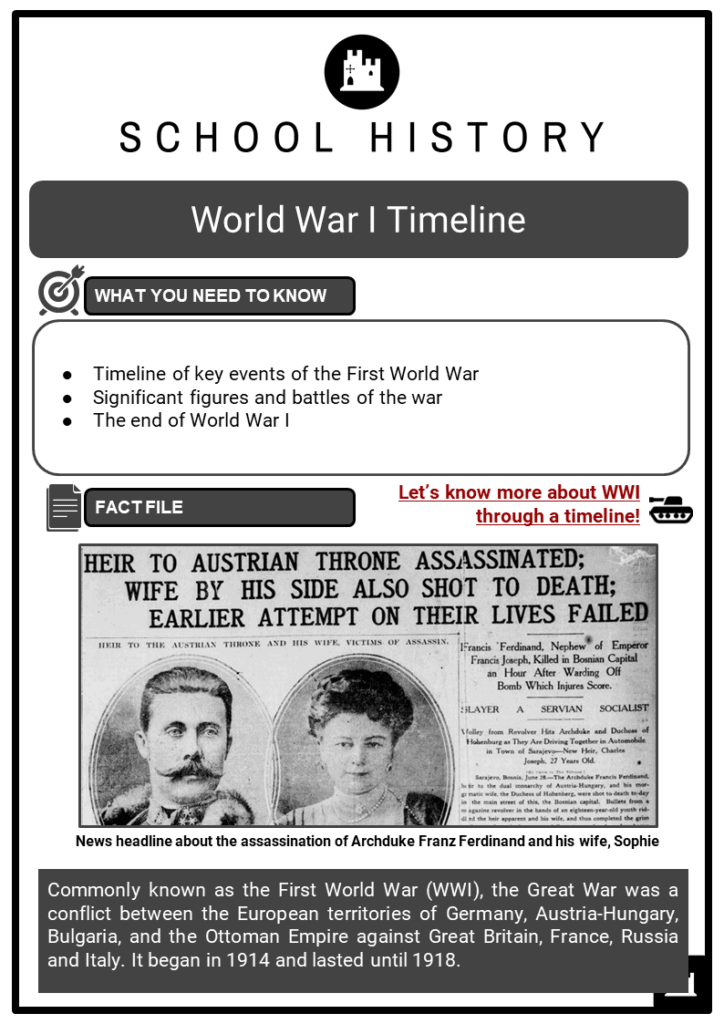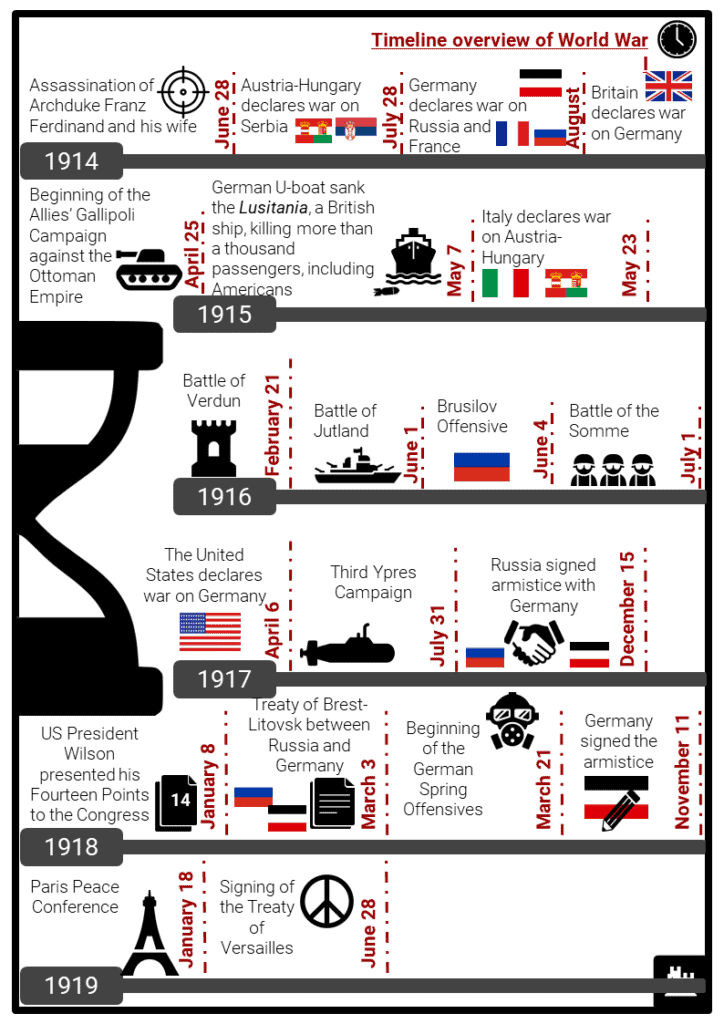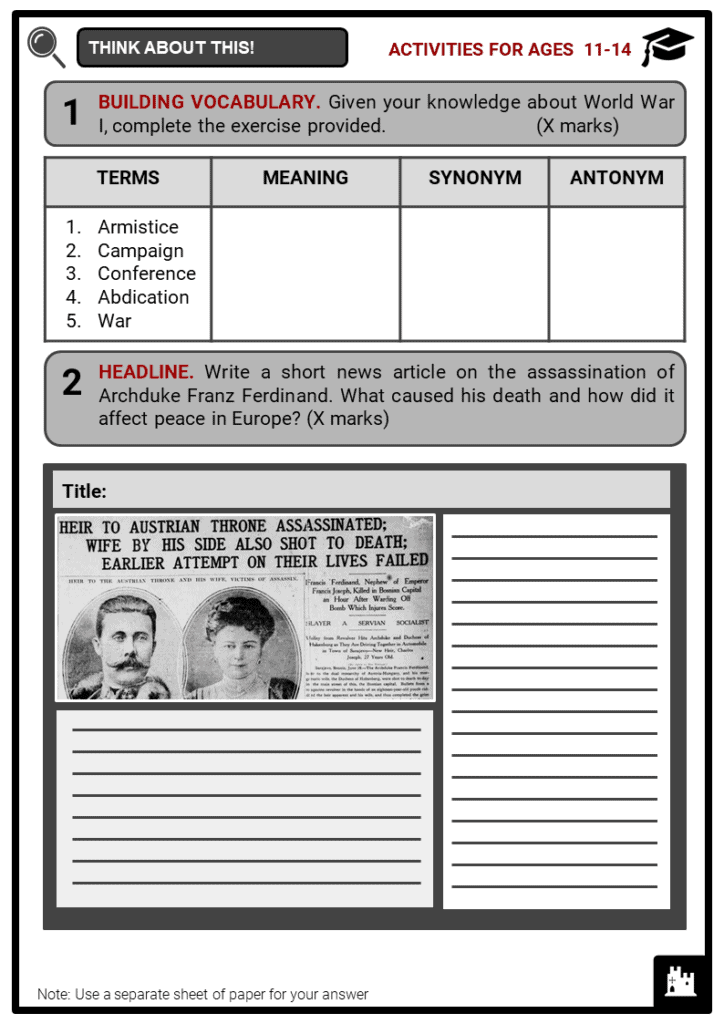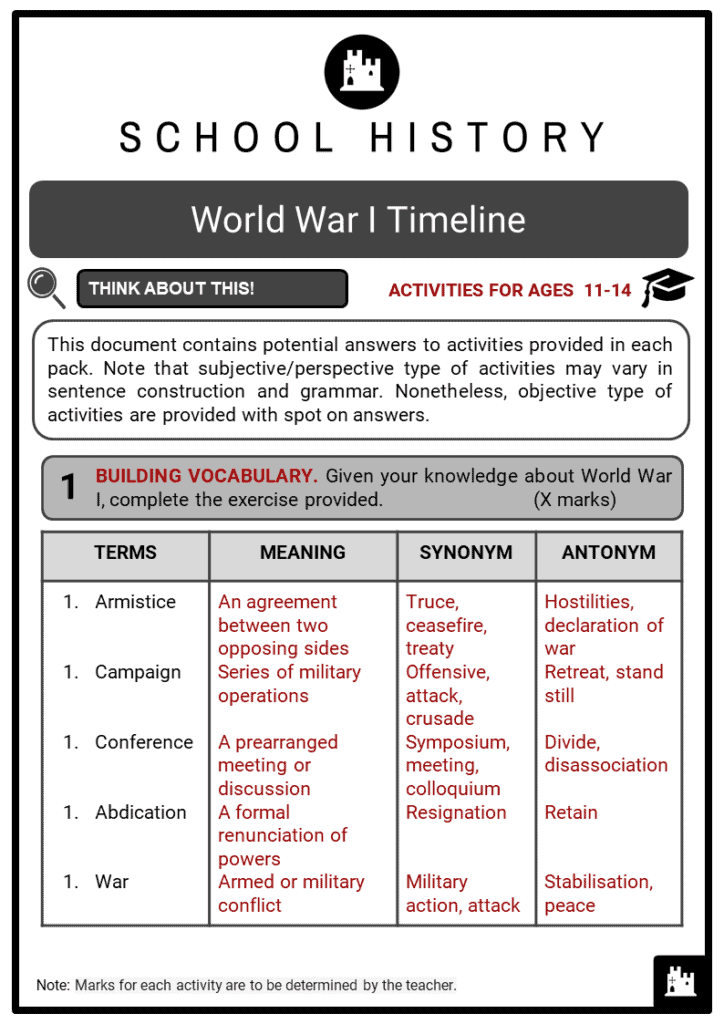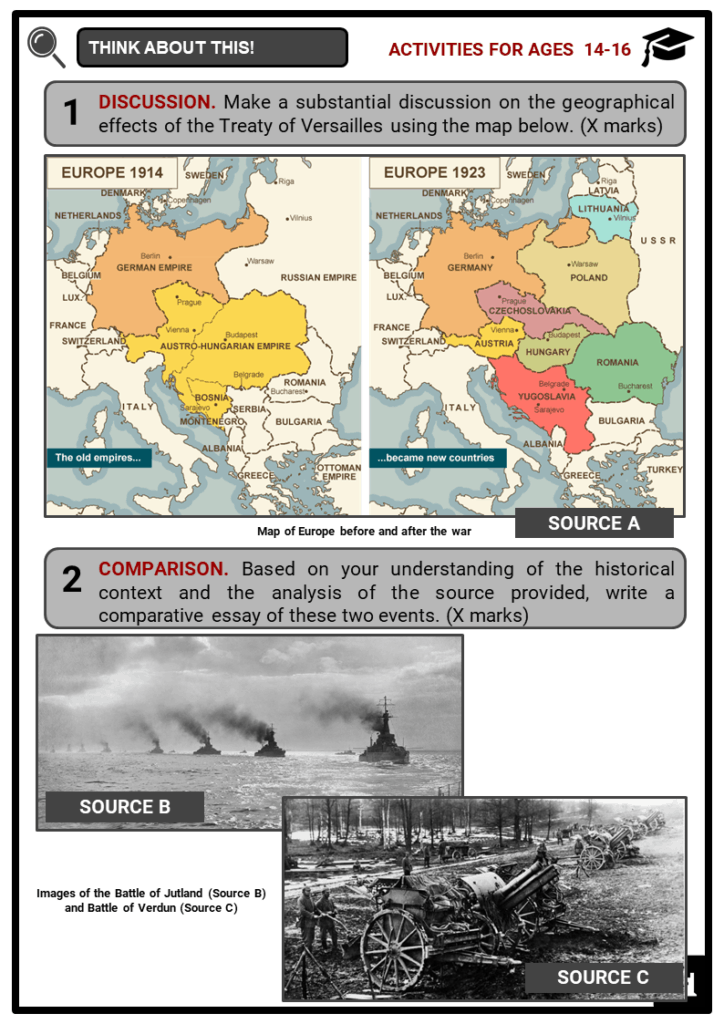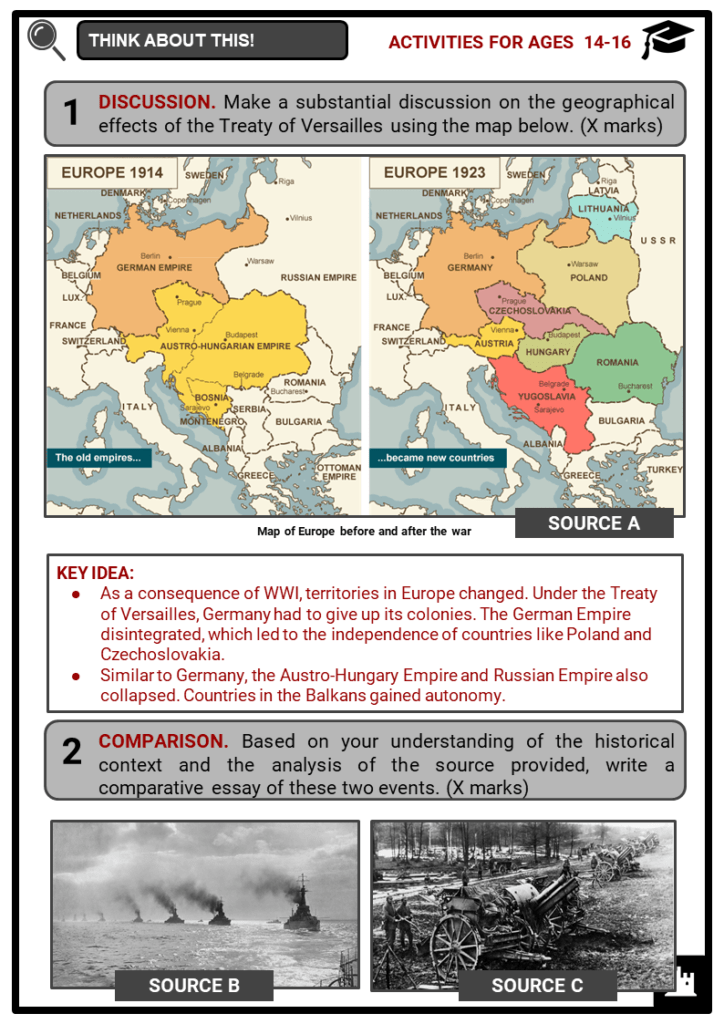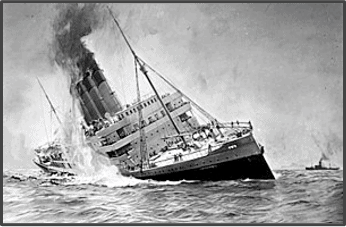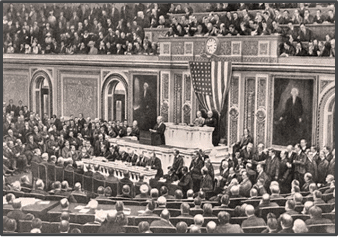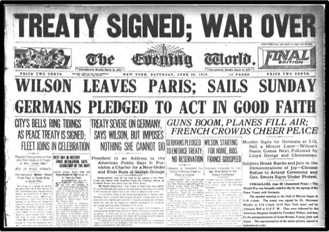Download World War I Timeline Worksheets
Do you want to save dozens of hours in time? Get your evenings and weekends back? Be able to teach World War I Timeline to your students?
Our worksheet bundle includes a fact file and printable worksheets and student activities. Perfect for both the classroom and homeschooling!
Table of Contents
Add a header to begin generating the table of contents
Summary
- Timeline of key events of the First World War
- Significant figures and battles of the war
- The end of World War I
Key Facts And Information
Let’s know more about WWI through a timeline!
- Commonly known as the First World War (WWI), the Great War was a conflict between the European territories of Germany, Austria-Hungary, Bulgaria, and the Ottoman Empire against Great Britain, France, Russia and Italy. It began in 1914 and lasted until 1918.
Key Events of World War I
June 28, 1914: Assassination of Archduke Franz Ferdinand
- The intensified form of nationalism amongst the Balkans led to the start of World War I through the assassination of Archduke Franz Ferdinand in Sarajevo on June 28, 1914 by a member of the ‘Black Hand’.
- The nationalist movement that had the biggest impact on the outbreak of war was the Slavic groups in the Balkans. Pan-Slavism was the belief that the Slavic people of Eastern Europe should be independent and have their own nation, and that they were a powerful force in the region.
- Pan-Slavism was mainly opposed to the Austro-Hungarian Empire and the control and influence it had over the region.
- Discontent was high and young Serbs joined radical nationalist groups like the ‘Black Hand’ because of Vienna’s annexation of Bosnia and Herzegovina.
- Groups like the ‘Black Hand’ wanted to drive Austria-Hungary from the Balkans to form a nation called Greater Serbia.
- Franz Ferdinand was the eldest surviving nephew and heir of Emperor Franz Joseph I. After the assassination, the ruler of the Dual Monarchy gave an ultimatum to Serbia.
- By the time of the declaration, Germany backed up Austria-Hungary. In response, Russia (a Serbian ally) mobilised its army. As a result, Germany and Austria-Hungary declared war on Russia, followed by France against Germany until other European nations had chosen sides.
The Gallipoli Campaign (17 February 1915 - 9 January 1916)
- The Gallipoli Campaign was an operation by the Allied Powers against the Ottoman Empire to control the sea route from Europe to Russia through the Dardanelles and to capture Constantinople. The goal was to link up with the Russians so they could join forces against the Ottomans and force the latter to retreat.
- Also known as the Dardanelles Campaign, this unsuccessful Allied attempt lasted until January 1916. The campaign was led by First Lord of the British Admiralty Winston Churchill. After the long-range bombardment of British and French battleships and Turkish abandonment of forts, the Allied troops were surprised with undetected mines and Turkish fire.
- The land invasion of the Gallipoli Peninsula began on 25 April 1915. They built two beachheads at Helles and Gaba Tepe.
- More reinforcements from Palestine and Caucasus arrived for the Ottomans. Allied defences were breached. By mid-October, after suffering 50% casualties, the Allied commanders proposed an evacuation.
- On December 7, evacuation began at Suvla Bay. At the end of the campaign, there were about 250,000 casualties on both sides, including 46,000 Allied deaths and 65,000 Turks.
- After the failed campaign, First Sea Lord Admiral John Fisher resigned from his post. Winston Churchill did the same but later accepted a command of an infantry battalion in France. Despite the tragedy, Churchill became Prime Minister during WWII.
- Gaba Tepe was later named as Anzac Cove in honour of Allied troops from Australia and New Zealand.
Sinking of the Lusitania and US participation - 7 May 1915
- In early 1915, the United States was neutral regarding the tensions of World War I in Europe. However, this stand changed due to the sinking of the Lusitania, a British passenger ship. The German U-boat attack killed 1,195 people, including 128 Americans.
- Due to intelligence indicating that British merchant and passenger ships were armed, Germany declared the waters near the British Isles a war zone. Clearly, Germany broke naval rules which alarmed the members of the Entente Powers. Six days after leaving New York for Liverpool, the Lusitania was torpedoed by a German U-boat submarine.
- As a result, many Americans who were supporters of neutrality began to feel anti-German sentiments.
- Despite the suggestion of former president Theodore Roosevelt, President Woodrow Wilson remained neutral on the causes of the war.
- In August of the same year, S.S Arabic (another British ocean liner) was sunk by a German U-boat. Again, Germany claimed that it was self-defence.
- Following President Wilson’s threat to cut diplomatic ties with Germany, the latter announced they would no longer attack passenger ships.
The United States joining WWI
- Despite two consecutive attacks on British passenger ships, the United States did not declare war against Germany. It was only in early 1917 that President Wilson officially informed the American public about US participation in WWI.
- British intelligence related to President Wilson a telegram between German Foreign Minister Arthur Zimmermann and Henrich von Eckhardt (German Minister to Mexico) which detailed their unrestricted submarine warfare.
- Outraged by the telegram and possible threat to the United States, President Wilson officially declared war on the Central Powers in April 1917. By June, American forces arrived in France.
Battle of Verdun - 21 February 1916 - 18 December 1916
- In order to secure German victory on the Western Front, Erich von Falkenhayn planned an attack on the ancient fortress city of Verdun, France. He aimed to dominate the surrounding area even before the Allies could consolidate power through the full deployment of the British forces. It became the longest battle in the course of WWI.
- The German Fifth Army began the artillery bombardment. After five days, Fort Douaumont, the highest fort at Verdun, was captured. Led by General Philippe Petain, the French were able to manage troops and survived days of battle. In late April, General Robert Nivelle replaced Petain and began massive counter attacks.
Battle of Jutland - 31 May - 1 June 1916
- The Battle of Jutland was the only major naval encounter between the main British and German battle fleets, which involved 250 ships and 100,000 men. The British naval fleet was intact after the battle and Germany made no further advancements to break the naval blockade. They were outgunned by British naval dominance, and so retreated.
- By the end of the battle, Britain had lost 14 ships and about 6,000 men, while the Germans lost 11 ships and over 2,500 men. Britain continued to implement the blockade until the end of the war in 1918.
Battle of the Somme - 1 July - 18 November 1916
- Also known as the Somme Offensive, the joint Franco-British campaign is considered to be one of the bloodiest military encounters in war history.
- The British forces, led by Gen. Douglas Haig and Gen. Douglas Rawlinson, started the attack from the northern region of the Somme, while the French troops came from the south. By August, the Allied naval forces had blocked both the North and Adriatic Seas, causing a food shortage in Germany.
- The German armies responded to the British tanks by deploying new planes in September. The battle incurred a total number of 420,000 British casualties, 200,000 French deaths, and nearly 500,000 German losses.
Third Ypres Campaign - July - November 1917
- Also known as Passchendaele, the Third Ypres Campaign saw great casualties on the Western Front. The success or failure of the campaign depended on the weather.
- Unseasonal rain created muddy conditions which made bombardment difficult. Drier weather in September made the offensive more favourable for the British forces.
- By November, Canadian troops had successfully captured Passchendaele. However, the railway that was needed to undermine the German position in Flanders was still five miles away. Due to heavy casualties on both sides, the offensive was called off.
US President Wilson’s Fourteen Points - 8 January 1918
- On 8 January 1918, US President Woodrow Wilson delivered a speech to the Congress containing his post-war vision. His Fourteen Points speech became an influential element on the Paris Peace Conference and later on the Treaty of Versailles.
- President Wilson’s Fourteen Points:
- There should be no secret treaties as a manifestation of proper diplomacy.
- All nations should have the freedom to navigate the seas.
- Economic barriers should be demolished through free trade.
- For public safety, all countries should reduce arms
- There should be fair rulings in colonial claims
- Restoration of Russian territories and freedom of its people
- Independence of Belgium
- Liberation and return of Alsace-Lorraine to France
- Clear demarcation lines on Italian frontiers
- Self-determination of people in Austria-Hungary
- Independence and self-determination of Balkan states
- Self-determination of those ruled under the Ottoman Empire
- Independence of Poland
- Establishment of an association to prevent and mediate international conflicts
Treaty of Brest-Litovsk - 3 March 1918
- Located in modern-day Belarus, Russia and members of the Central Powers signed the Treaty of Brest-Litovsk which concluded military conflict between them. Due to growing discontent among their peasants and workers, the Russian government ended its participation in the war.
- While World War I was happening in Europe, the majority of the Russian population joined a revolution against Czar Nicholas II. Led by Vladimir Lenin, the Bolsheviks dominated Petrograd.
- A month after the February Revolution, Czar Nicholas II abdicated the throne and became the last of the Romanov Dynasty.
- After seizing power of the Provisional Government, Lenin declared a formal ceasefire with the Central Powers on 15 December 1917.
- Seven days later, negotiations at Brest-Litovsk began. Leon Trotsky represented Russia, while Richard von Kuhlmann and Count Ottokar Czernin stood for Germany and Austria respectively.
- Under the treaty, Russia recognised the freedom of Ukraine, Georgia and Finland. They also surrendered Poland, Lithuania, Latvia and Estonia to Germany and Austria-Hungary. While Kars, Ardahan and Batum was ceded to the Ottoman Empire. All in all, about 1 million square miles of Russian territory was lost and a third of its population.
- This territorial loss also gave up the majority of their coal, iron and oil mines. For the Russians, the treaty was a total humiliation.
German Spring Offensives - 21 March - 17 July 1918
- On 21 March 1918, Operation Michael was a success for the Germans. The British troops met gas, smoke and infantry which bent the Allied line. The German Offensives were the last attempt to defeat the Allies. Though winning, the Germans suffered high casualties until the tides turned for the Allies. A unified defence was employed by Marshal Ferdinand Foch.
- After the Treaty of Brest-Litovsk with Russia, Germany planned to strengthened its force in the Western Front. Operation Georgette followed on the 9th April which targeted Flanders. Despite their quick advances, the Germans failed to capture the Hazebrouck Rail Hub. Later in May, Operation Blucher was launched to divert the French army.
- German troops were able to reached Paris, but failed to damage the Allies. In August, the Allied forces responded with a counter-attack which forced the Germans to retreat.
Signing of the Armistice and the Paris Peace Conference - November 1918 - January 1919
- On 11 November 1918, World War I ended with an armistice. The Central Powers and Entente Powers agreed to stop the fighting and end the growing casualties of the war.
- After the final negotiations of the armistice, Germany agreed to pull out troops in France, Luxembourg and Belgium. Moreover, they surrendered their arsenal, including thousands of artillery pieces, machine guns, railroad locomotives, trucks, and wagons.
- Germany also agreed to cede Alsace-Lorraine and the Rhine. The majority of the German population found the armistice humiliating. As a result, many resented the government. Similar to Russia, Kaiser Wilhelm II abdicated the throne, the Weimar Republic weakened which later gave way to the rise of the Nazi Party.
The Treaty of Versailles - 28 June 1919
- The armistice signed in November 1918 was prolonged three times until the Treaty of Versailles, signed on 28 June 1919. By the end of the war, the Central Powers led by Germany faced defeat. The treaty signed in the Palace of Versailles held Germany responsible for the war, thus obliging them to pay penalties.
- Key Features of the treaty
- Under Articles 45-40, Germany was forced to surrender about 10% of its territory and all overseas possessions. The German Empire collapsed, while its former territories gained independence. Alsace-Lorraine was returned to France as stipulated in Article 51. Based on Article 80, Austria was liberated, as well as Czechoslovakia in Article 81-86.
- In order to avoid another possible war, Articles 159-163, stipulated limitations on Germany’s army and navy, and total abolition of their air force. About 100 seaplanes were allowed only for minesweeping. Moreover, conscription or compulsory enlistment of civilians in the national service was banned.
- A five-judge tribunal was created to put former Kaiser Wilhelm II on trial, however, it never really happened. The Netherlands where Wilhelm II fled refused to extradite him.
- Based on Articles 227-230, about 17 Germans were put to trial. Some were acquitted, while others received light sentences.
- Commonly known as the ‘war guilt clause’, Article 231 obliged Germany to pay the Allies $33 billion dollars for the damages of the war.
- Due to the expenses of the war and Germany’s economic loss, they struggled to pay the reparations. As a result, the French occupied the Ruhr which later exacerbated the German economy.
Image sources:

